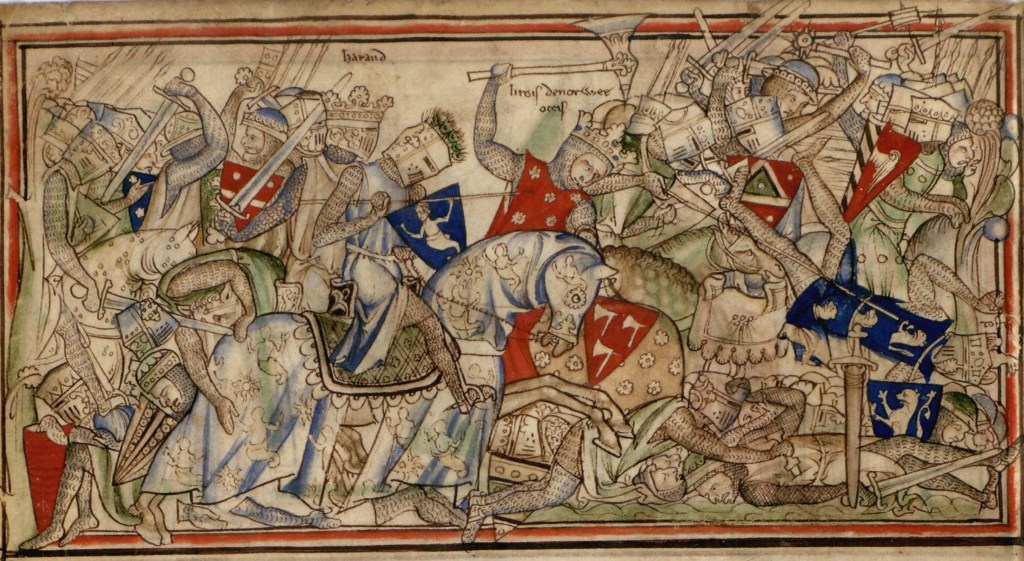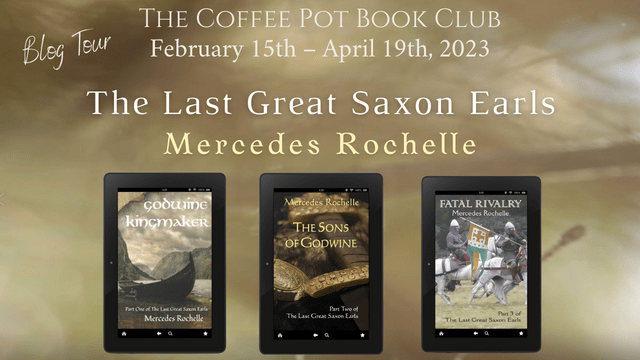Today, I am delighted to host Mercedes Rochelle on her tour for Godwine Kingmaker, part of the Last Great Saxon Earls series. Mercedes has kindly contributed an article on Tostig and Harold (see below).
You can follow the complete tour here: https://thecoffeepotbookclub.blogspot.com/2023/01/blog-tour-last-great-saxon-earls.html
GODWINE KINGMAKER by Mercedes Rochelle
They showed so much promise. What happened to the Godwines? How did they lose their grip? Who was this Godwine anyway, first Earl of Wessex and known as the Kingmaker? Was he an unscrupulous schemer, using King and Witan to gain power? Or was he the greatest of all Saxon Earls, protector of the English against the hated Normans? The answer depends on who you ask.
He was befriended by the Danes, raised up by Canute the Great, given an Earldom and a wife from the highest Danish ranks. He sired nine children, among them four Earls, a Queen and a future King. Along with his power came a struggle to keep his enemies at bay, and Godwine’s best efforts were brought down by the misdeeds of his eldest son Swegn.
Although he became father-in-law to a reluctant Edward the Confessor, his fortunes dwindled as the Normans gained prominence at court. Driven into exile, Godwine regathered his forces and came back even stronger, only to discover that his second son Harold was destined to surpass him in renown and glory.
Buy Links:
This series is available on Kindle Unlimited
Universal Link: https://books2read.com/u/38VrJZ
Audio: https://www.audible.com/pd/Godwine-Kingmaker-Audiobook/B09JFJCY3G
TOSTIG AND HAROLD’S SIBLING RIVALRY
by Mercedes Rochelle
To this day, more than 950 years after the Norman Conquest, many of us are still fascinated by the causes of this pivotal event—and I am one of them. If Harold Godwineson hadn’t been 260 miles away fighting his brother when Duke William landed at Pevensey, things might have gone differently. So where does Tostig come into this? From outlawry to Stamford Bridge, Tostig was on the wrong side of the law. In his last battle, he seems to have been second in command after Harald Hardrada and has been branded as a traitor ever since.

Battle of Stamford Bridge: Cambridge University Library MS. Ee.iii.59
It was thought by many that Tostig himself persuaded Hardrada to invade, thus forcing King Harold to rush north and defend his kingdom against the Vikings. However, this conclusion is by no means certain; nobody was tracing Tostig’s movements in the early part of 1066. It’s entirely possible that the Norwegian King planned the invasion on his own, and Tostig merely fell in with his army when the time came. There is no doubt that Hardrada was the leader of the Viking invasion. What exactly Tostig thought to accomplish is uncertain. Perhaps he only wanted his old earldom back. Or, he might have bargained to rule his old earldom as sub-king to Harald. Maybe he hoped Hardrada would get killed and he could rule in his stead, unlikely though that sounds.
But why was Tostig fighting against his brother, anyway? This was the question that inspired me to write THE SONS OF GODWINE and FATAL RIVALRY. Why was he outlawed? How could Harold allow his brother to go off in such a rage that he would come back with an invading army? Surely Tostig had his reasons; such a devastating turn of events could have not come about arbitrarily.
In a situation like this, matters usually deteriorate over the course of time. Harold and Tostig were only a couple of years apart. Was there rivalry from their boyhood? Did Tostig feel left out? When Tostig became Earl of Northumbria, his brother had already been Earl (first of East Anglia and then of Wessex) for 10 years. What did Tostig do all that time? There was no catching up; by 1055 Harold was practically the “right hand” of King Edward, and frequently took on responsibilities that the king didn’t want to be bothered with. When Tostig helped his brother during the Welsh campaign of 1063, what was his reward? Harold was lauded as a great warrior because of this campaign; Tostig barely received mention, and may well have emptied his coffers to help pay for it. Could this have contributed to the stress between them?
The real trouble started in 1065; up until then Tostig had ruled Northumbria for 10 years without any major disturbance. However, after the Welsh campaign he found himself obliged to impose new taxes on this previously undertaxed earldom. Some have said that Tostig needed to pay for the campaign. Other historians suggested he was urged to do so by Harold, acting in concert with the king who wanted to bring the north more in line with his southern provinces. There were some political assassinations that might have contributed to the unrest, but most historians agree that taxation issues pushed the troublesome thegns to revolt.
King Edward the Confessor, detail from the Wilton Diptych – Wikipedia
And what a revolt it was! Tostig was in the south hunting with King Edward when thegns from all over Yorkshire and Northumberland gathered in York and attacked the Earl’s housecarls, catching them totally unprepared. Although Tostig’s 200+ troops tried to fight back, they were unable to mount an organized defense and were killed almost to a man. The rampaging rebels broke into the armory, destroyed Tostig’s manors, and raided the treasury, making off with all the carefully gathered taxes.
Next on the agenda was to call a witan and elect a new Earl: Morcar, younger son of Earl Aelfgar of Mercia—who just happened to be standing by. This was a totally illegal move and the rebels knew it, so they proceeded to rampage their way south and force the issue with the king. Enter Harold, who was delegated to mediate for Tostig. King Edward and Tostig had every reason to believe Harold would get what they wanted, so they were more than horrified when their negotiator came back with rebels in tow. Morcar and his supporters didn’t trust Harold and insisted that the king be confronted personally with all their demands. A second round of negotiations ensued, and Harold was still unable to budge the rampaging Northumbrians. They declared that Tostig had to go and that Morcar be officially declared Earl, or else they would continue their depredations into East Anglia.
Tostig went into a rage and accused Harold of fomenting the rebellion himself. In self-defense, Harold offered his sworn oath that he was not responsible but Tostig was having none of it. Edward wanted to raise the fyrd and teach his errant subjects a lesson, but the late season and poor support for Tostig’s cause were enough to foil the king’s empty threats. Edward eventually backed down and gave into the rebel demands, though the loss of royal prestige was a blow the king never recovered from. Just over a month later, King Edward was dead.
Tostig left the country voluntarily enough, loaded with gifts from the king but still swearing revenge against his brother. Apparently Harold washed his hands of the whole situation, for he is not recorded attempting to offer Tostig any compensation until the battle of Stamford Bridge. Even after he became king, Harold supported the wily sons of Aelfgar (his former rivals) and even married their sister to prove that Tostig was not coming back. Tostig may have found this doubly insulting. By the time they faced each other on the battlefield, Harold is said to have offered back the earldom if Tostig would lay down his arms. When Tostig asked what Harold was prepared to offer Hardrada, we hear the famous line “Seven feet of English ground, or as much more as he may be taller than other men.” At this response, Tostig righteously refused his brother’s offer. (I still find this episode a little implausible; it came from Snorri Sturluson, whose account may be somewhat apocryphal.)
So his sense of betrayal was surely a driving force for Tostig’s attempted return. But there is another factor to remember: there were plenty of precedents for an Earl to rampage his way back into favor. Earl Godwine did it in 1052, and Harold himself was part of that reunion; his bloody encounter at Porlock left behind 30 dead thegns and countless others. Even Aelfgar, Morcar’s father, wreaked havoc on two occasions (the first causing the destruction of Hereford in 1055); both times he was restored to his earldom. So Tostig was just following suit; of course, his allies were a bit more powerful than Aelfgar’s!
Author Bio:
Mercedes Rochelle is an ardent lover of medieval history, and has channeled this interest into fiction writing. She believes that good Historical Fiction, or Faction as it’s coming to be known, is an excellent way to introduce the subject to curious readers. She also writes a blog: HistoricalBritainBlog.com to explore the history behind the story.
Born in St. Louis, MO, she received by BA in Literature at the Univ. of Missouri St.Louis in 1979 then moved to New York in 1982 while in her mid-20s to “see the world”. The search hasn’t ended!
Today she lives in Sergeantsville, NJ with her husband in a log home they had built themselves.
Social Media Links:
Website: https://mercedesrochelle.com/
Twitter: https://twitter.com/authorrochelle
Facebook: https://www.facebook.com/mercedesrochelle.net
Book Bub: https://www.bookbub.com/authors/mercedes-rochelle
Amazon Author Page: https://www.amazon.com/stores/Mercedes-Rochelle/author/B001KMG5P6
Goodreads: https://www.goodreads.com/author/show/1696491.Mercedes_Rochelle





Thanks so much for hosting Mercedes Rochelle today, Pam. Much appreciated. xx
LikeLiked by 1 person